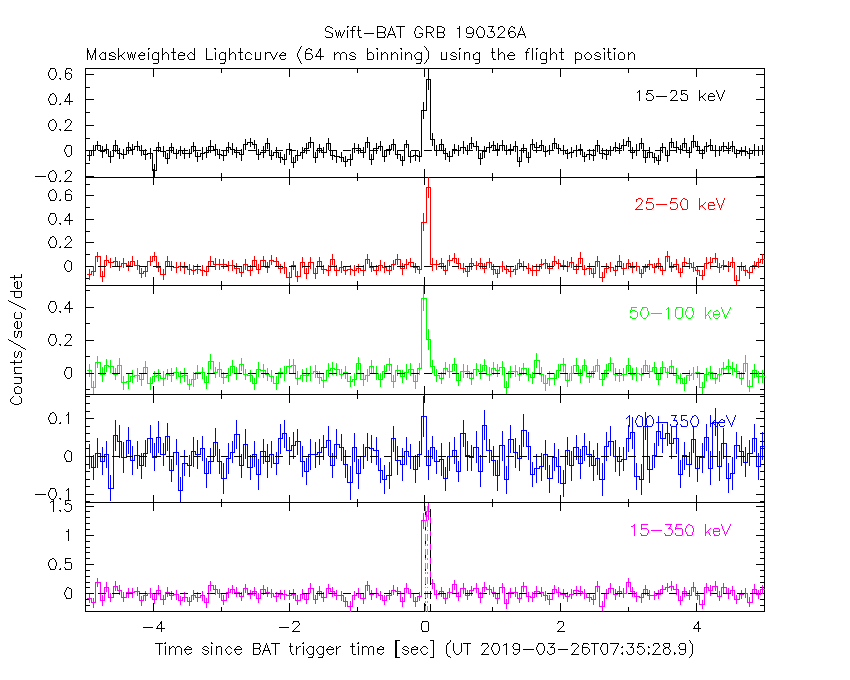
M.H. Siegel (PSU) and B. Sbarufatti (PSU) for the Swift team
At 07:35:28 UT, the Swift Burst Alert Telescope (BAT) triggered and located GRB 190326A (trigger=895006) (Siegel et al. GCN Circ. 24009). Due to an observing constraint, Swift did not slew to the burst. At the time of the trigger, the initial BAT position was 43° from the Sun (1.5 hours West) and 101° from the 68%-illuminated Moon. Table 1 contains the best reported positions from Swift.
Table 2 is a summary of GCN Circulars about this GRB from observatories other than Swift.
Standard analysis products for this burst are available at https://gcn.gsfc.nasa.gov/swift_gnd_ana.html.
As reported by Markwardt et al. (GCN Circ. 24020),
the BAT ground-calculated position is RA, Dec = 341.652, 39.914 deg which is RA(J2000) = 2
The mask-weighted light curve (Figure 1) shows a FRED-like pulse structure that starts and peaks at ~
The time-averaged spectrum from T+0.00 to T+0.10 s is best fit by a power law with an exponential cutoff.
This fit gives a photon index -0.67 ± 0.92, and
If this is a GRB, this is one of the softest short bursts detected by BAT (based on a sample with constrained spectral fits from the 3rd BAT GRB catalog; Lien & Sakamoto et al. 2016). Another BAT-detected short GRB with similar softness and duration is GRB140622A, which was classified to be a short GRB because the XRT light curve (Figure 1) is consistent with the normal behavior of a short burst (Sakamoto et al. 2014; Burrows et al. 2014). Unfortunately, due to the observing constraint, we do not have information from XRT/UVOT, and thus it is difficult to determine the burst origin at this point. Further X-ray observations may clarify the physical origin.
The results of the batgrbproduct analysis are available at https://gcn.gsfc.nasa.gov/notices_s/895006/BA/.
Analysis of the initial XRT data was reported by Sbarufatti et al. (GCN Circ. 24129).
UVOT results are not available.

Figure 1. The BAT
mask-weighted light curve in the four individual and total
energy bands. The units are counts
| RA (J2000) | Dec (J2000) | Error | Note | Reference |
|---|---|---|---|---|
| 2 |
+39°54'50.3" | 1.6' | BAT-refined | Markwardt et al. GCN Circ. 24020 |
| Band | Authors | GCN Circ. | Subject | Observatory | Notes |
|---|---|---|---|---|---|
| Optical | Niwano et al. | 24016 | MITSuME Okayama optical upper limits | MITSuME Okayama | upper limits |
| Optical | Hu et al. | 24023 | 2.2m CAHA telescope optical limit | CAHA | upper limits |
| Gamma-ray | Luo et al. | 24018 | Insight-HXMT/HE detection | Insight-HXMT | |
| Other | Biltzinger et al. | 24010 | Fermi Trigger 575278303 / GRB 190326314 / GRB190326B: BALROG localization |
| Filter | Exp(ks) | Mag | ||
|---|---|---|---|---|
| uvw1 | 1633 | 1640 | 1.89 | >20.47 |
Table 3. UVOT observation reported by Sbarufatti et al. (GCN Circ. 24129). The start and stop time of the exposure are given in seconds since the BAT trigger. The preliminary 3-σ upper limit is given. No correction has been made for extinction in the Milky Way.
April 19, 2019